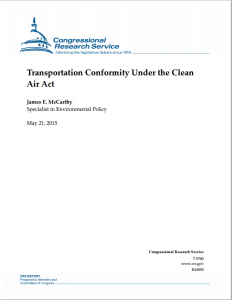Full Title: Transportation Conformity Under the Clean Air Act
Author(s): James E. McCarthy
Publisher(s): Congressional Research Service
Publication Date: May 1, 2015
Full Text: Download Resource
Description (excerpt):
Under the Clean Air Act, areas that have not attained one or more of the six National Ambient Air Quality Standards (currently more than 100 areas with a combined population of 143 million) must develop State Implementation Plans (SIPs) providing for implementation, maintenance, and enforcement of the NAAQS. The act requires that, in these areas, federal agencies not engage in, approve, permit, or provide financial support for activities that do not “conform” to the area’s SIP. Although a wide range of federal funding and programs is subject to conformity, it as transportation planning (and ultimately highway funding) that is most commonly affected. Before a new transportation plan or transportation improvement program (TIP) can be approved by the Federal Highway Administration or Federal Transit Administration or a new non-exempt project can receive federal funding in a nonattainment area, a regional emissions analysis must generally demonstrate that the projected emissions from the entire transportation system, including the new projects, are consistent with the emissions ceilings established in the SIP. While some express concern at the potential impact of these conformity determinations in delaying or altering new highway projects, others note that the process simply obligates the federal government to support rather than undermine the legally adopted state plans for achieving air quality.
In the late 1990s and early 2000s, there were numerous lapses of conformity: 63 areas, in 29 states and Puerto Rico, had lapses between 1997 and 2003. In 2005, however, Congress amended the Clean Air Act to provide a 12-month grace period to demonstrate compliance following an area’s designation as nonattainment before conformity will lapse. Since 2007, only seven areas have experienced a conformity lapse, despite the imposition of more stringent ambient air quality standards for both ozone and particulate matter. All but one of the lapses since 2007 were resolved within a year.
As Congress considers reauthorization of surface transportation programs this year, questions have again been raised regarding the impact of conformity requirements, and whether the Environmental Protection Agency’s (EPA’s) current proposal to strengthen the ambient air quality standard for ozone will affect the number of areas required to make conformity determinations. Particular concern has been expressed for rural areas that may never have been classified nonattainment for an air quality standard before. The number of areas ultimately affected will depend on numerous factors, including the level at which EPA sets the final ozone standard and trends in emissions and weather in the period before EPA designates any new nonattainment areas. Although these factors introduce elements of uncertainty in future projections, most rural areas are unlikely to be designated nonattainment for the ozone standard, because they do not have ozone monitors in place. In the few rural areas that have been designated nonattainment, conformity needs only to be determined if there is a non-exempt transportation project that depends on federal funding or approval—a rare occurrence. In addition, EPA’s conformity regulations provide exceptions for areas with insignificant motor vehicle emissions, which may facilitate the demonstration of conformity in any rural areas that will be designated nonattainment.
This report explains the statutory conformity requirements, reviews the recent history of their implementation, and examines how conformity requirements might affect areas designated nonattainment for a revised ozone air quality standard.
